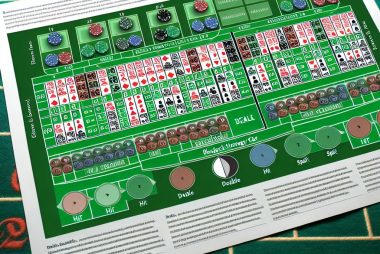The role of probability in blackjack strategy
The Importance of Probability in Blackjack Strategy
Blackjack is a widely popular casino game that involves a mix of both skill and chance. Gaining a fundamental understanding of probability can significantly elevate a player’s strategy and, ultimately, improve their gameplay outcomes. In this article, we will delve into how probability plays a pivotal role in shaping decision-making strategies during a game of blackjack.
Understanding Basic Probability in Blackjack
In the game of blackjack, players strive to obtain a hand value that is closer to 21 than the dealer’s hand, without surpassing this number. The calculations related to probabilities in blackjack revolve around anticipating the likelihood of certain cards being dealt. By understanding these probabilities, players can determine the optimal moves for each hand dealt.
Each card within a standard 52-card deck has a specific probability of being drawn. For example, the probability of drawing any particular card is 1 in 52, equating to approximately 1.9%. However, as cards are drawn and removed from the deck, these probabilities adjust, which, in turn, affects the likelihood of drawing specific cards in subsequent rounds.
Using Probability to Make Informed Decisions
Players can harness the power of probability to make decisive game choices, such as whether to hit, stand, double down, or split pairs. Consider a scenario where a player has a total of 16 while the dealer’s face-up card is a 7. In this case, deciding whether to hit or stand involves calculating the probability of drawing a card that will not result in busting the hand. Similarly, probability can inform decisions on when it might be advantageous to split pairs or choose to double down.
Basic Strategy and Probability
A basic strategy chart is often used in blackjack to guide players in making statistically optimal moves based on the hand they are dealt and the dealer’s up-card. These charts are derived from intricate probability calculations and provide a roadmap for making favorable decisions in specific scenarios. For instance, a widely accepted understanding based on probability analysis advises players to stand when holding a hand total of 17 or higher since any additional card increases the risk of busting significantly.
The Impact of Card Counting
Card counting is an advanced strategy employed by experienced blackjack players, which hinges heavily on probability. Rather than concentrating on individual hands, card counters maintain a tally of the ratio of high to low-value cards remaining in the deck. When there is an abundance of high-value cards (10s, face cards, and Aces) in comparison to low-value ones, the probability of being dealt a blackjack rises, which shifts the odds in favor of the player. It is essential to note that while card counting is not illegal, it is not welcomed by casinos and may result in players being banned from the premises.
Probability in Blackjack Variations
There are several variations of blackjack, such as Spanish 21 and Double Exposure Blackjack, each of which alters specific rules and, by extension, the probabilities involved in gameplay. These modifications necessitate changes in strategic decision-making. For instance, in Spanish 21, all 10s are inexplicably removed from the deck, which changes the probabilities substantially and often leads to different strategic decisions compared to classic blackjack.
In Spanish 21, the absence of 10s means players need to reassess the likelihood of achieving certain hand totals. As the probability dynamics shift, players must adjust their strategies to accommodate these differences. Similarly, in games like Double Exposure Blackjack, where both of the dealer’s cards are revealed, players have access to more information upfront, affecting the calculation of probabilities and subsequent decision-making strategies.
Adapting to Changing Probabilities
One of the key challenges in blackjack is adapting to the constantly changing probabilities as cards are dealt. This requires players to continually recalculate odds and reassess their strategies. A successful player implements an adaptable strategy, adjusting their decisions based on shifting probabilities. This adaptability is critical in staying competitive and maximizing winning potential over time.
The Role of Decks and Shuffling
The number of decks used in a game of blackjack can significantly influence probability calculations. Most casinos utilize multiple decks in a shoe, which impacts the probability of specific card outcomes. In general, more decks increase the difficulty of card counting and probability computation due to the larger pool of possible card combinations.
Additionally, frequent shuffling or the use of automatic shuffling machines further complicates probability calculations by continuously altering the card composition. Players must remain vigilant and swiftly adjust their strategies in response to these changing conditions to maintain an advantage.
Skill Development Through Probability
A deep understanding of probability fosters the development of essential skills that underpin successful blackjack strategies. Players who actively study and apply probability principles in gameplay can make more informed decisions and reduce their reliance on mere chance. This, in turn, elevates their gameplay to a strategic level backed by quantitative analysis rather than intuition alone.
Strong analytical skills combined with practical experience allow players to recognize patterns, assess risks, and make quick, informed decisions. These skills are not only applicable to blackjack but can also enhance strategic thinking across various other games and decision-making scenarios.
Conclusion
In conclusion, probability is an integral component of mastering blackjack strategy. By understanding and utilizing probabilities, players can make informed decisions that maximize their potential for success. It is important to recognize that while probability cannot guarantee success in every individual game, it is a foundational element that shapes strategies to increase the odds of winning over time. For those interested in further exploring blackjack strategies and the role of probability, consulting resources from experienced gaming theorists or statistical experts can offer deeper insights and enhance strategic gameplay.




